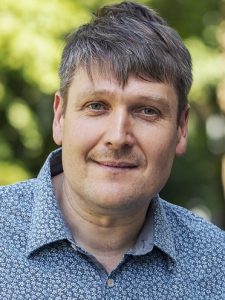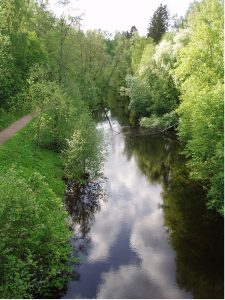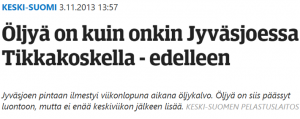
Marko Lamberg is a Collegium Researcher at the Turku Institute for Advanced Studies and the Department of Scandinavian Languages
A couple of weeks ago, Mikel Calle Navarro discussed the concept of the river in his exciting entry in this same blog. I spontaneously commented it, because I had previously pondered the same problematic, albeit in a different context.
As someone who has been born in Jyväskylä, Central Finland, I, too, had learned that the first inhabitant of the region was a certain Heikki Ihannuksenpoika who lived along the Jyväsjoki river at the beginning of the sixteenth century. However, not until I had started my project with pre-modern location descriptions, I realised that I did not know where Jyväsjoki was situated. Nowadays, almost no one uses that name, and one cannot find it on official maps either. Several rivers flow through the areas the town of Jyväskylä consists of, but they have completely different names. The Digital Name Archive (Nimiarkisto), maintained by the Institute for the Languages of Finland, knows Jyväsjoki, but its map locates it on a dry slope far away from Jyväskylä.
In the local historical literature, I found that the name Jyväsjoki, which probably originally meant ‘Grain River’, had evolved to a settlement name, Jyväskylä (‘Grain Village’). Historians and linguists had already stated that in several works, but no one had analysed this process in detail. Moreover, no one had asked why the present-day town of Jyväskylä is not called Jyväsjoki. And where does or did that river lie?
I found the name Jyväsjoki in court protocols and taxation lists from the sixteenth century when it had been used both as a name of a river and of a settlement. Apparently, the Jyväsjoki river was much longer than the area of the Jyväsjoki settlement. That posed problems for both the local inhabitants and for the early modern government as it was necessary to define exactly where taxpayers dwelled and where their lands were situated. Some inhabitants and administrators chose to use another, more precise name, Leppäkoski (‘Alder Rapid’) regarding the settlement in the area. The government used even a third toponym, Palokka (‘Burnt Land’), referring to slash-and-burn cultivation method practised by the early inhabitants, and decided that the two northernmost farmsteads should be treated as a separate village under that name. That is how the settlement of Jyväsjoki/Leppäkoski got a boundary in the north, but the name Jyväsjoki did not disappear. In fact, it outlasted the competing name Leppäkoski for reasons we can merely guess: perhaps Jyväsjoki was older and more established, perhaps many felt that Leppäkoski referred to a too limited area in the local space. However, Jyväsjoki changed as a settlement name: firstly, contemporaries began speaking of Jyväsjoen kylä (‘Grain River Village’), but long toponyms tend to shorten, so already during the late sixteenth century the official and most widely accepted name of the settlement was Jyväskylä. However, Jyväsjoki continued to exist as a river name.
But although I was able to clarify this process’s outlines, I still did not know where this river was situated. However, I managed to find four references to it in present-day contexts. Firstly, there is a hydrological measurement station along the Tourujoki river in the vicinity of the present-day town centre of Jyväskylä; secondly, the Luonetjoki river which flows through the community of Tikkakoski (‘Woodpecker Rapid’) approximately 17 kilometres northward from the Jyväskylä centre is occasionally spoken of as Jyväsjoki; thirdly, the former school building along the Luonetjoki river is still called Jyväsjoen koulu (‘Jyväsjoki School’); and finally, the bridge over the Köntysjoki river, approximately 23 kilometres northwestward from the Jyväskylä centre, is called Jyväsjoen silta (‘Jyväsjoki Bridge’). All the aforementioned rivers – Tourujoki, Luonetjoki/Jyväsjoki and Köntysjoki – seem to carry same waters (and sediments) from north to southward, to Päijänne, which is the longest lake in Finland. The name of Tourujoki seems to refer to a person name, apparently one of the early settlers, whereas köntys in modern Finnish means a clumsy person, although as a river name it probably just meant ‘slow’. What Luonetjoki meant originally is more difficult to say, but linguists analysing toponyms have suggested that it is somehow connected to water, perhaps to a term signifying flooding waters.

The Tourujoki river which flows mostly in a deep valley belonged once to the southernmost parts of the water route called Jyväsjoki. Picture: Juan Ramirez/Wikimedia Commons.
Luckily, I was able to find a description of the length and course of the Jyväsjoki river in a book published in 1863 and written by Claes Wilhelm Gyldén, the superior director of the Finnish Forestry and Geodesy Board. Gyldén also published a map depicting Finland, and his map contained even a visualisation of the course of Jyväsjoki. Apparently, the river was approximately 35 kilometres long, and it ran through several lakes before it reached Jyväskylä and Päijänne, the longest lake in Finland. The idea that a river runs through several lakes and keeps its name felt quite unfamiliar, so I checked several dictionaries and etymological dictionaries, and I even took a closer look upon the Finnish legislation and its definitions. It appeared that there is no universal definition regarding what actually a river is. For those early hunters, fishers and settlers who came to Central Finland in the Middle Ages, it was convenient to use just one name when they were, in fact, referring to a longer water route leading from Päijänne to the north. It did not matter them that they occasionally passed water bodies which also could be spoken of as lakes. Problems arose only when the permanent settlement which formed along the water route had to be separated from the water route itself as a concept of its own. For the descendants of the settlers as well as for later-day settlers, it was more natural to regard lakes as start and endpoints for individually named rivers. Consequently, the water route once spoken of as Jyväsjoki is nowadays spoken of as a series of several rivers and lakes, the above-mentioned Tourujoki, Luonetjoki and Köntysjoki being some of the names given to shorter sections of the route. Most likely, these alternative names were used already when Gyldén published his book and his map.

After a leakage from a sewer, a headline in the local newspaper Keskisuomalainen, published in Jyväskylä on 3 November 2013, stated that there was still oil in the Jyväsjoki River in Tikkakoski, a community approximately 17 kilometres northward from the Jyväskylä centre. This is a rare example of the use of the old name Jyväsjoki in modern contexts. It has not appeared in local newspapers during the last years, but at least birdwatchers use it occasionally when they report their observations in the Tikkakoski area.
Regarding the blurred memory of Jyväsjoki, I have suggested to the Museum of Central Finland that it could collect still existing oral history regarding the name. Perhaps there are still some chapters of the story of Jyväsjoki which have not been told yet.
I have treated the problem of Jyväsjoki more detailed in my article (in Finnish) in Lähde – historiatieteellinen aikakauskirja . There are not so many works written in English and dealing with the history or geography of the Jyväskylä region, but those who are interested in Finnish rivers or Finnish geography in general can utilise the Map Site of the National Land Survey of Finland.

Thank you for such an exiting article! One thing that came to my mind: it might be interesting to consult experts of Saami language history on those toponyms. I have understood that there may have been Saami speakers in Central and Eastern Finland still in Middle Ages, and there are toponyms of Saami origin all over the Finland. Even some words that look like Finnish may have interesting roots.
Thanks for this! Yes, also in Central Finland there are a plenty of toponyms which can be linked to the Saami language. I have not seen that anyone would have tried to explain Jyväsjoki or Jyväskylä as containing influences from the Saami culture, but several other toponyms can indeed be explained as remnants from the Saami period, like the lake name Iso-Kuukkanen which possibly contains the same word which exists nowadays in northern Saami as guhkki ‘long’.